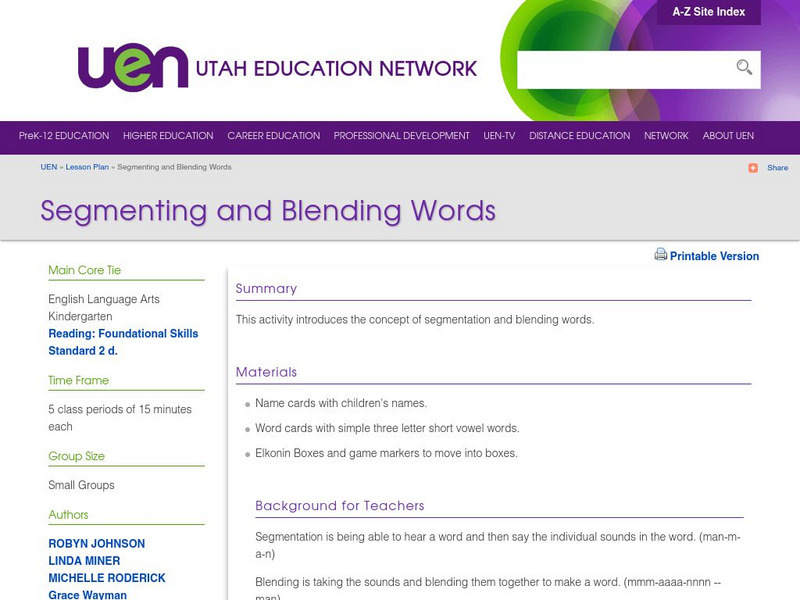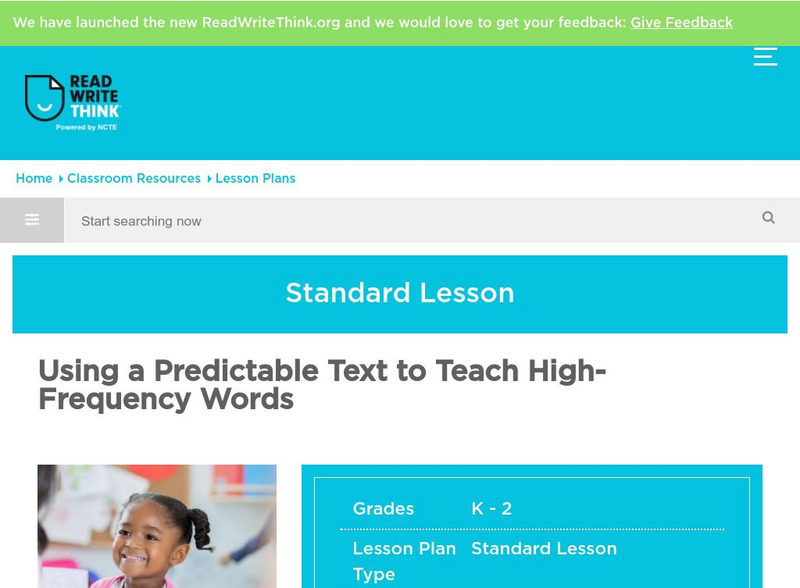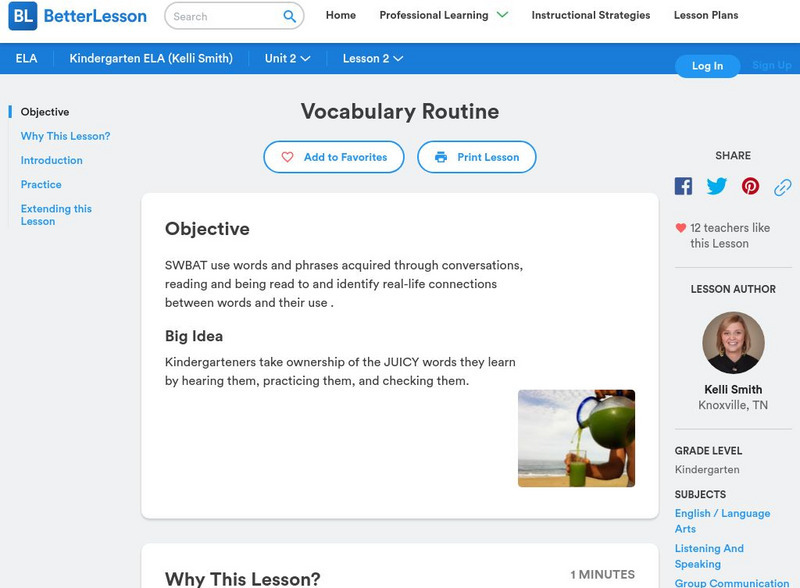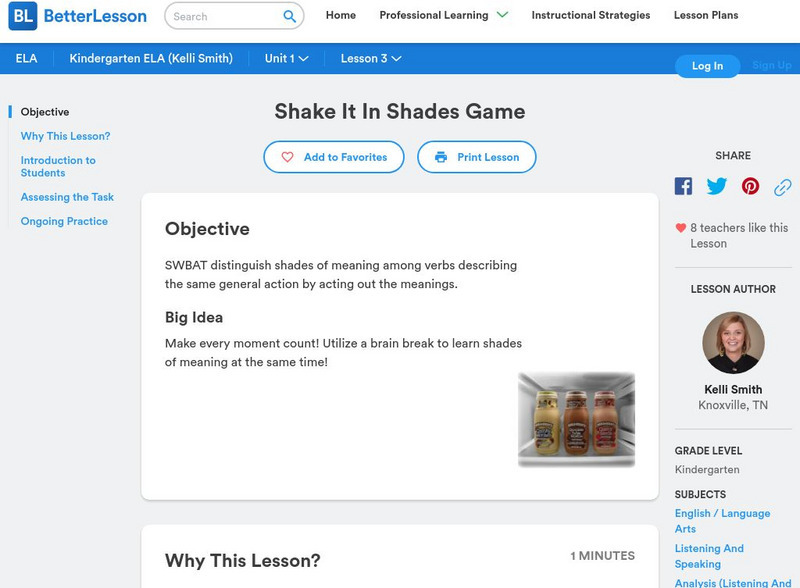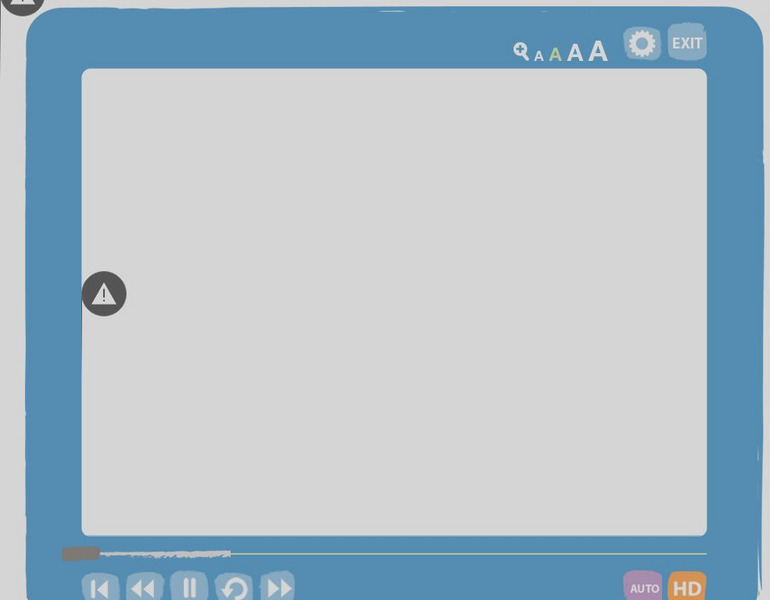ReadWriteThink
Read Write Think: Word Recognition Strategies Using Nursery Rhymes
This lesson is a great way to teach students about rhymes and word recognition. This plan includes suggest nursery rhymes for you to use, and several supplementary sites to help you out.
Free Reading
Free Reading: Vocabulary Activities Find Activities
A fantastic reading skills site emphasizing vocabulary activities. This site contains 54 individual vocabulary activities to click on, and provides teaching tips as well. It is still in the building phase, and more activities, tips, and...
TES Global
Tes: 100 High Frequency Words (Hf Ws) Display/flashcards
[Free Registration/Login Required] One high flashcards with high frequency words are provided at this site.
Utah Education Network
Uen: K Act. 08: Language Arts Writing Experience
Teachers will model sentences about their favorite foods. Students will mimic these sentences about their own favorite foods and will illustrate pictures of them. All pages will be assembled into a class book.
Utah Education Network
Uen: Segmenting and Blending Words
For this lesson, students will learn how to segment words. Then students will play a segmentation game that utilizes Elkonin boxes and markers.
Free Reading
Free Reading: Free Reading: Sounding Out Activities
A wonderful site full of tips for teaching the skills of sounding out words. This site has a plethora of links that provide an excellent way to practice and memorize the essential skills of sounding out words. The links using every...
Free Reading
Free Reading: Free Reading: Alien Word Game: Sounding Out
A game where students distinguish between real words and "alien" or nonsense words.
Free Reading
Free Reading: Around the World Game: Sounding Out Accuracy
A fun game involving the entire classroom that builds word and sound recognition phonetically.
Read Works
Read Works: Lessons: Real and Make Believe
[Free Registration/Login Required] A lesson plan and materials to teach kindergarten students classify and categorize based on real and make-believe.
ReadWriteThink
Read Write Think: Using a Predictable Text to Teach High Frequency Words
Using "Have You Seen My Cat?" learners will learn to recognize high-frequency words. There are supplementary materials provided, as well as several links to useful websites.
Education.com
Education.com: Words That Make Us Feel: A Lesson on Sensory Language
[Free Registration/Login Required] After this lesson centered around the book Owl Moon, students will be able to identify words and phrases that suggest feelings and appeal to the senses.
Other
Berkeley County Schools: 2nd and 3rd Grade Writing Folder
This writing packet includes all final product tasks and writing process resources for all 2nd and 3rd grade students. Lists of transition words, homophones, parts of speech, and more are included.
Better Lesson
Better Lesson: Guess My Solid
Descriptive details are used as students develop a guessing game poster for others to try and guess their chosen solid. Included in this detailed lesson plan are videos, samples of student work, a printable worksheet, an assessment...
Better Lesson
Better Lesson: Vocabulary Routine
Kindergarteners take ownership of the JUICY words they learn by hearing them, practicing them, and checking them. The following routine supports children to own their words! Instead of the teacher introducing the word and giving the...
Better Lesson
Better Lesson: Shake It in Shades Game
Make every moment count! Utilize a brain break to learn shades of meaning among verbs at the same time! Included in this lesson is a video of the activity, a reference chart, and a list of fun verbs to act out.
St. Charles Place Education Foundation
Reading Bear: Blends (Ending, Part 1) Lesson
In this beginning reading module, the instructor models how to pronounce words that incorporate blends in them. Students are prompted to interact with the video segments at various times. Students can choose to sound out words, see words...
Starfall
Starfall: Make a Magician
Fun magician-related activities for early readers learning to follow directions. Dress a magician, then label all the articles of clothing before performing some magic tricks. All the activities combine audio and basic words to assist...
Better Lesson
Better Lesson: Word Detective
For this lesson, students will become word detectives to find spelling patterns in a story, and then sort the words they find according to the patterns. This "word detective" will become a favorite independent activity throughout the...
St. Charles Place Education Foundation
Reading Bear: Old, Olt, Ow Lesson
In this beginning reading module, the instructor models how to pronounce words that incorporate "old", "olt", and "ow" to form words with the long /i/. Students are prompted to interact with the video segments at various times. Students...
Better Lesson
Better Lesson: Onset Rime Segmenting and Blending
This lesson offers routines for blending and segmenting onsets and rimes of single-syllable spoken words. Included is a video showing students practicing this skill and ideas for centers.
Reading Rockets
Reading Rockets: Onset/rime Games
Similar to teaching beginning readers about rhyme, teaching children about onset and rime helps them recognize common chunks within words. This can help students decode new words when reading and spell words when writing. This article...
PBS
Pbs Learning Media: Vocabulary Words: Graphic Organizer
This graphic organizer can help students as they explore new vocabulary words. It offers a place for a dictionary definition, as well as a place to practice using the word in a sentence.
PBS
Pbs Learning Media: Sight Word Spelling Lesson Plan
In this lesson plan students explore with movement and creativity to make words come alive! Using sight word flashcards, students use their bodies to spell out simple sight words.
PBS
Pbs Learning Media: Pre K 12 Resources for New School Routines: All About Emotions: Pre K and K
These weekly activities are cross-curricular but emphasize Social-Emotional Learning, Math, and Literacy development. This week children will learn to label emotions and how they can express them in different ways.






